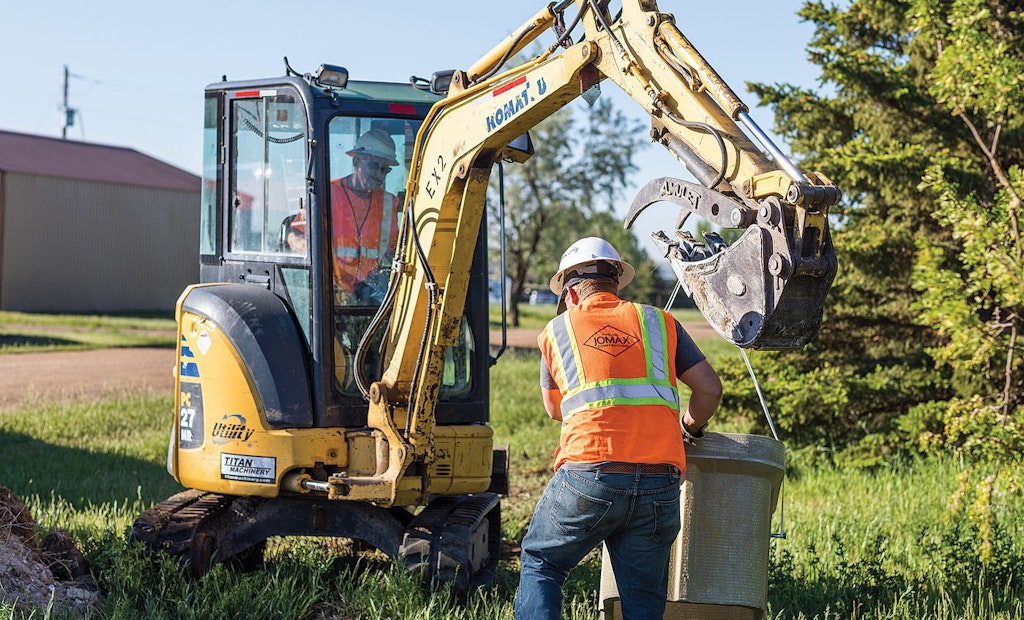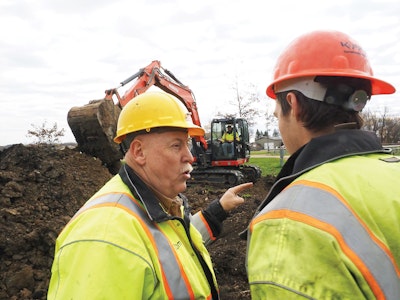
These workers are wearing proper reflective vests and hard hats while moving components during an installation. (file photo)
It’s the height of the construction season, and onsite installers are likely juggling the greatest number of projects right about now. Often caught between a builder’s schedule and customers who want the job done yesterday, installers can face multiple unreal deadlines in the late summer. You’re hustling to meet everyone’s timelines while dealing with distraction and exhaustion at the same time.
What does that mean? Mistakes can be made. And we’re not just talking about an error in the slope of a drainfield pipe or failure to order enough bedding stone for a work site. God forbid you face a safety violation that results in the injury of one of your valued teammates. Working in haste, corners can be cut or your crew might forget one safety step that could endanger everyone moving earth and laying pipe that day.
So it’s a good time to review the most common safety snafus that companies face in construction-related industries. And it’s easy to do that because the Occupational Safety and Health Administration reports the Top 10 most frequently cited workplace safety violations every year. The federal agency has released the 2019 numbers, and most of the categories could touch on the onsite industry.
Here’s the 2019 list with the number of violations and the percentage change in violation totals compared to 2018:
- Fall Protection, 6,010 citations, down 17%
- Hazard Communication, 3,671 citations, down 19%
- Scaffolds, 2,813 citations, down 16%
- Lockout/Tagout, 2,606 violations, down 12%
- Respiratory Protection, 2,450 citations, down 46%
- Ladders, 2,345 citations, down 17%
- Powered Industrial Trucks, 2,093 citations, down 12%
- Fall Protection – Training Requirements, 1,773 citations, down 11%
- Machine Guarding, 1,743 citations, down 12%
- Eye and Face Protection, 1,411 citations, down 8%
We have work to do
Lorraine Martin, president and CEO of the National Safety Council, had this to say when the new Top 10 list was announced: “Far too many preventable injuries and deaths occur on the job. The OSHA Top 10 list is a helpful guide for understanding just how adept America’s businesses are in complying with the basic rules of workplace safety. This list should serve as a challenge for us to do better as a nation and expect more from employers. It should serve as a catalyst for individual employees to recommit to safety.”
Martin’s advice is important and should be heeded every day when workers and installer team leaders head out in the field. I have similar thoughts every time — it’s far too often, actually — that I see a photo submitted for an Onsite Installer feature that shows an obvious safety violation. It might be a worker without a hard hat or high-visibility vest shoveling under the bucket of an excavator. Sometimes it’s a worker standing deep in a trench with no shoring equipment or nearby ladder for exit. Or it’s a septic technician or inspector working around wastewater without gloves or eye protection.
Interpreting the list
When you examine the OSHA list, obvious trouble spots emerge for the installer community. Let’s look at a few areas where the general workforce — and wastewater professionals — could make some improvement:
• Fall protection. Adding railings on elevated platforms comes to mind when you think of fall protection. But installers face other falling hazards, such as working on and around tanks being placed in excavations or on uneven terrain with operating machinery. Refresher training and effective company-provided personal protective equipment can go a long way to preventing these mishaps.
• Lockout/tagout. This speaks to the control of hazardous energy — machinery that produces dangerous electrical, mechanical, hydraulic, pneumatic and other energy. It could be your power tools, your earth-moving equipment, electrical panel work — everyday tasks that, if not properly safeguarded, could lead to injury or death. Lockout means securing with locks all tools or equipment that can pose a hazard. Tagout means tagging equipment that cannot be locked with a prominent warning device that must be removed before equipment is operable.
• Machine guarding. Have you inspected your machinery lately to ensure it will be operated safely? Workers have been known to remove safety guards that seem to make work inconvenient or slow down operations. But it is the company’s responsibility to use all appropriate factory-installed safety equipment on machinery or face potential fines when an OSHA inspector visits a work site.
• Eye and face protection. Aside from proper shoring of excavations, the lack of PPE — including safety glasses, hard hats and gloves — represents the most frequent OSHA violations I see at work sites and in photos that come to the magazine. Think of how crucial and fragile your eyesight is. And how would you be able to function without the use of your hands? Be sure to have your crew geared up the right way to protect their bodies … and their livelihood.
Sobering statistics
At first glance, the 2019 decline in citations for each category on the Top 10 list looks like good news. But enforcement efforts are likely lagging, too. OSHA total workplace inspections declined from 39,228 in 2013 to 32,408 in 2018. Many news outlets have reported a decline in the number of OSHA inspectors enforcing safety laws in recent years.
Even if you take OSHA’s statistics into account, it seems certain that violations are commonly missed in the onsite industry and across the construction industry in general. The agency says it has 2,100 inspectors to track the safety of 130 million workers on 8 million work sites across the country, meaning there is one compliance officer for every 59,000 workers. In 2018, OSHA reported that 5,250 workers died on the job, which is 3.5 per 100,000 workers, or an average of more than 100 deaths per week, or 14 per day.
Certainly any number of workplace fatalities is too many. And while OSHA clearly has a positive impact on safety compliance across the construction industry, we can’t rely on those inspectors alone to protect our onsite workforce. It’s up to everyone in the onsite industry to promote safety every day.







